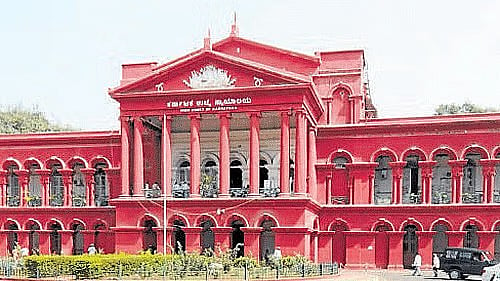
High Court of Karnataka
Credit: DH Photo
Bengaluru: The Karnataka High Court directed the Urban Development Department to issue a circular restricting its officers from granting permission to put up new constructions in and around the protected monuments.
If any permission is to be granted in tune with the statute, such permission shall precede a no objection from the Archeological Survey of India (ASI).
“The circular shall also indicate that permissions if granted by officers contrary to law, they would be doing so at their peril, making themselves open for initiation of a departmental enquiry,” Justice M Nagaprasanna said while ordering a departmental enquiry against the erring officials for permitting construction within 64 meters from the Mangaladevi temple, a protected monument in Mangaluru city.
In the case at hand, petitioner Denis Crasta had got the property at Mangaluru Thota Village, Mangaluru Taluk, measuring 8.80 cents, pursuant to a decree in a partition suit. On September 27, 2023, the Deputy Commissioner, Dakshina Kannada allowed his application and granted conversion of the land. Subsequent to this, the petitioner moved the Mangalore City Corporation seeking a licence to construct a house which was granted on December 21, 2023.
At this stage, the petitioner received a stop notice from the Conservative Assistant of Archaeological Survey of India, Karkala Sub-Circle. The notice stated that he had to take a 'no objection' from the Archaeological Survey of India before commencement of the construction, as the construction was coming within the regulated area of 150 meters on north-east side of Mangala Devi Temple, a protected monument under the Ancient Monuments and Archaeological Sites and Remains Act.
The petitioner moved the high court after he received a communication informing him that the 'no objection' had been refused after the spot inspection report revealed that the property falls within 64 meters from the Mangala Devi Temple. The petitioner contended that the property is only a regulated area and not a prohibited area or protected area. He further submitted a Google earth image showing that the property is more than 151.1 meters from the Mangala Devi Temple.
The court noted that the Act only provides repair or renovation of an earlier existing building around the protected monuments, while the plan in the case at hand is for a ground floor and first floor and more so a new construction. The court also pointed out that the Google image produced by the petitioner is deliberately shot from a different angle and enlarged so that the distance would change.
“Article 49, a part of the directive principles of the state policy mandates protection of monuments and places and objects of national importance. It is the obligation of the State to protect every monument of historic interest. If this is the mandate of the Constitution, in terms of law and when Mangala Devi Temple is declared to be a protected monument, it is understandable as to how the Corporation has granted permission to put up a new construction, that too without keeping Archaeological Survey of India in the loop, is deeply perturbing. Permission is granted in blithe ignorance or indifference to the statutory embargo. Public functionaries are the custodians of the law, not its adversaries,” Justice Nagaprasanna said.